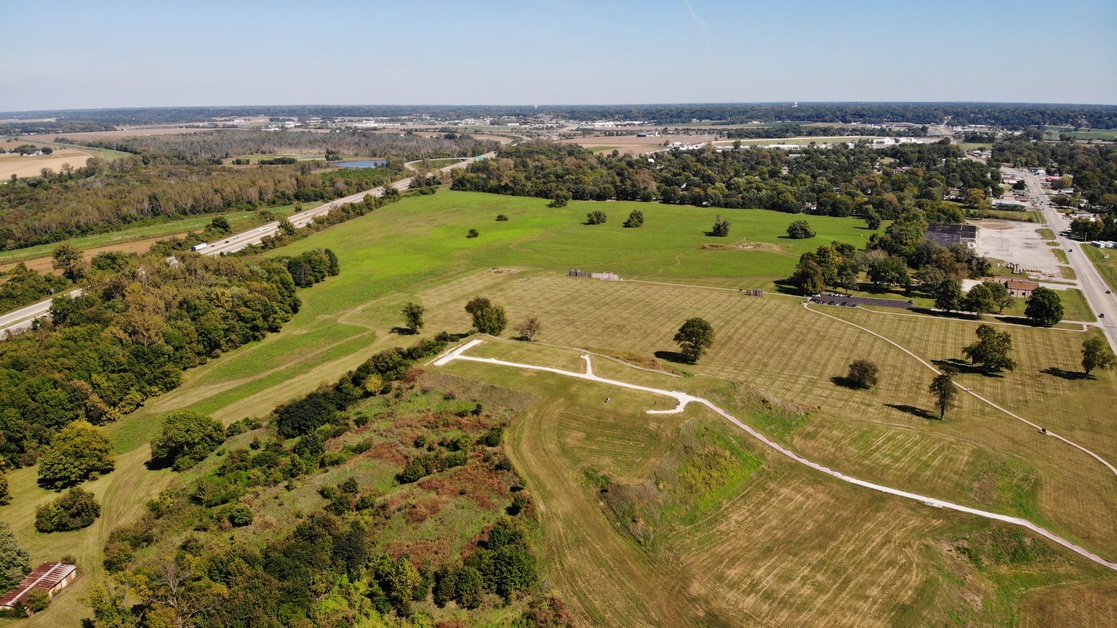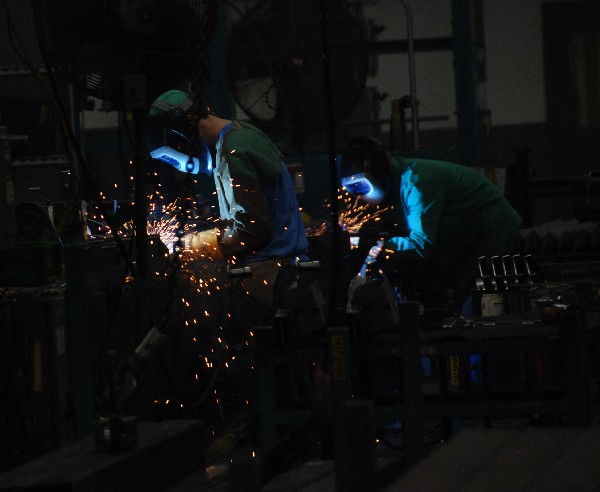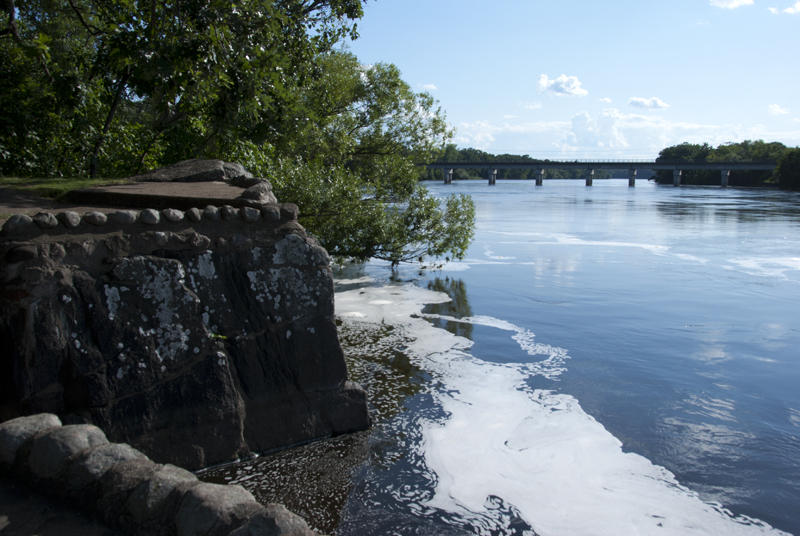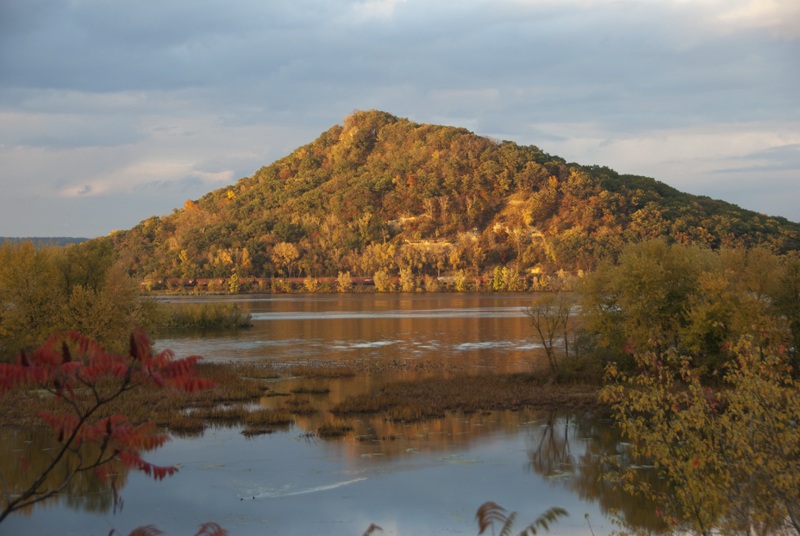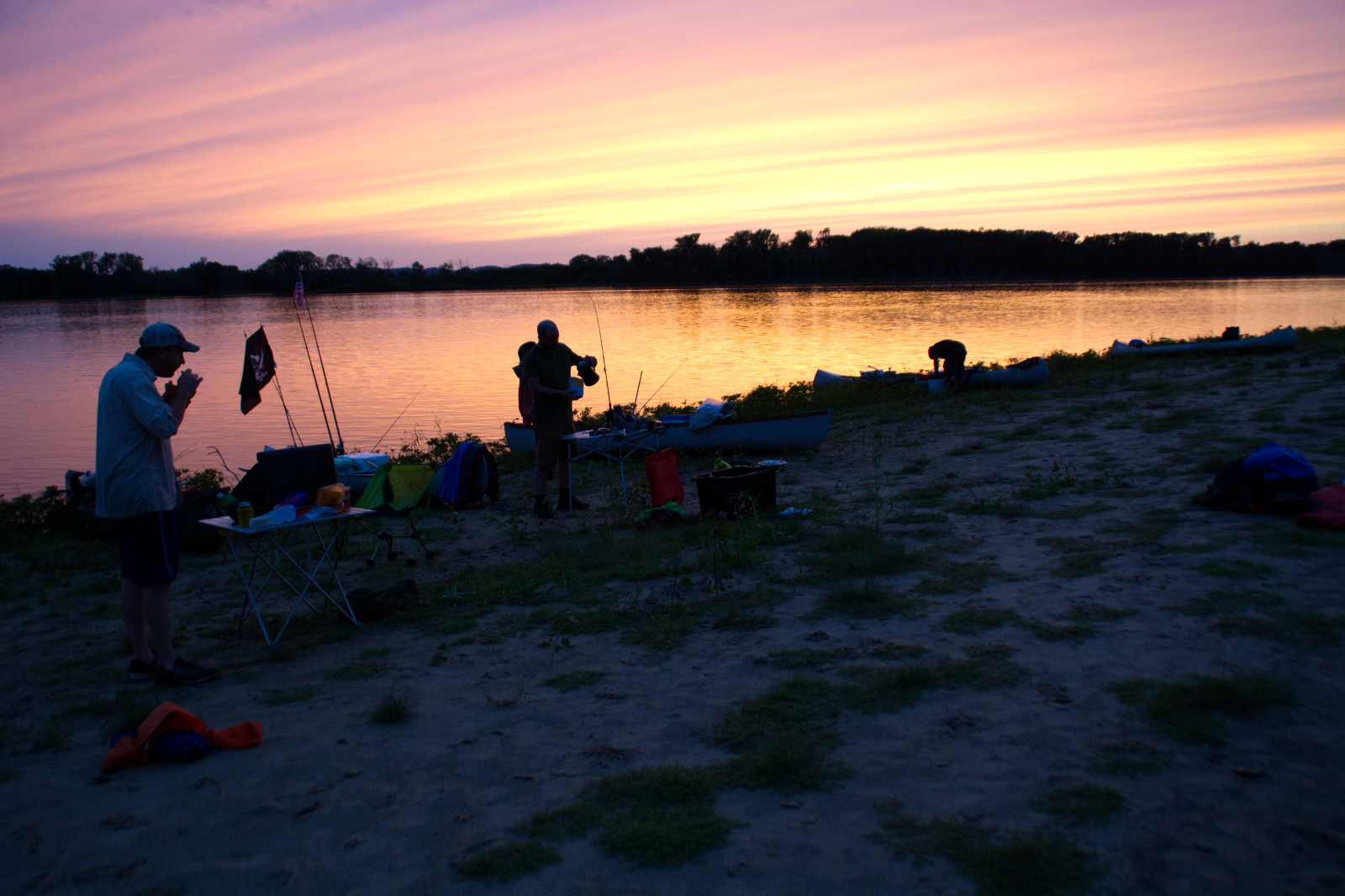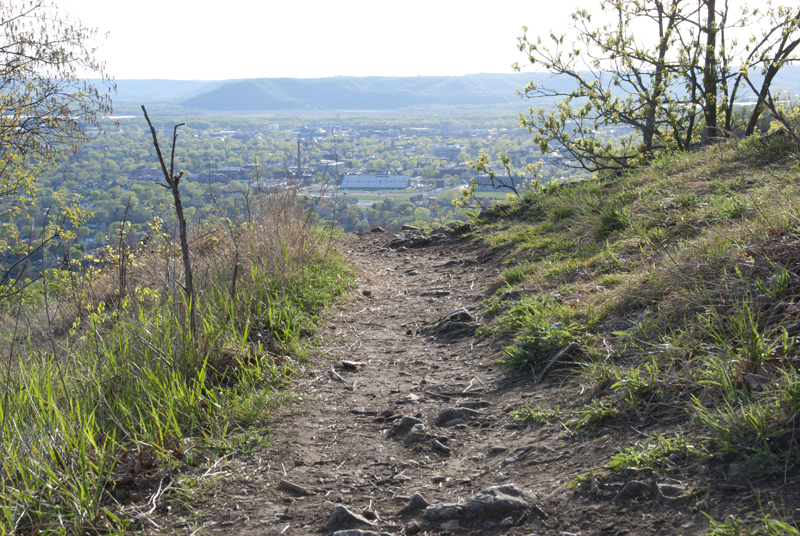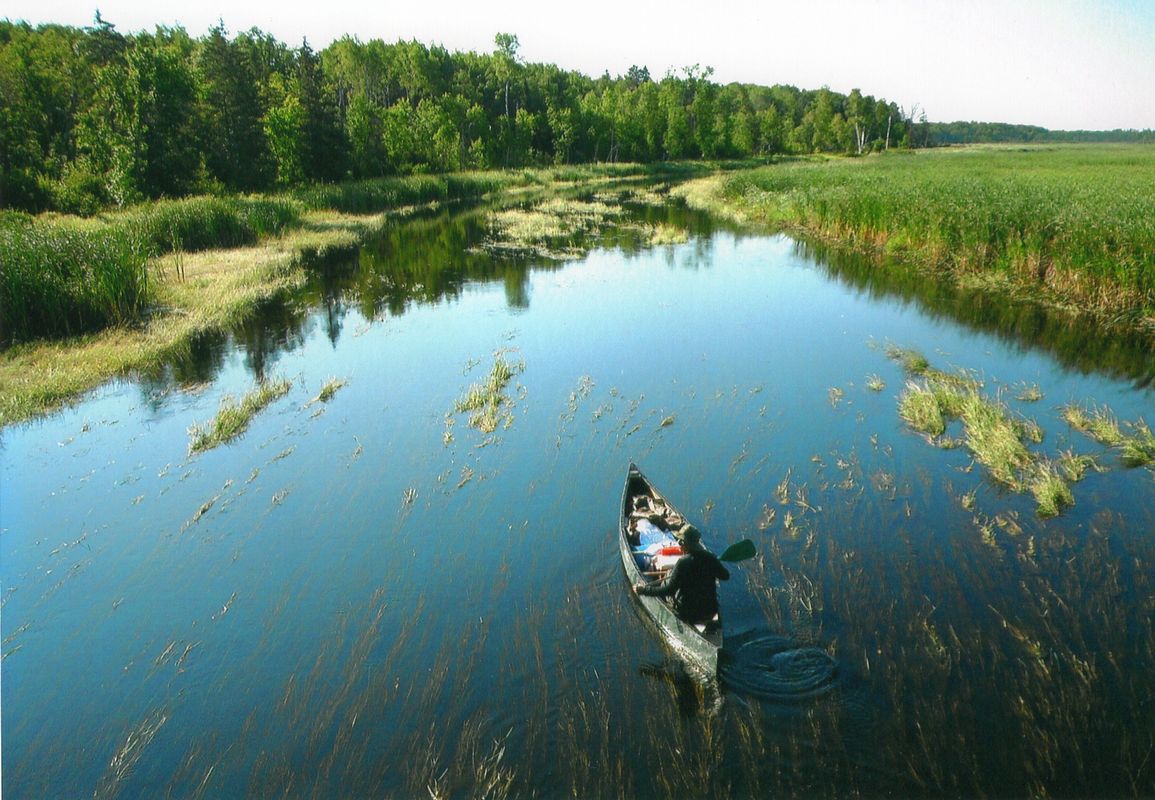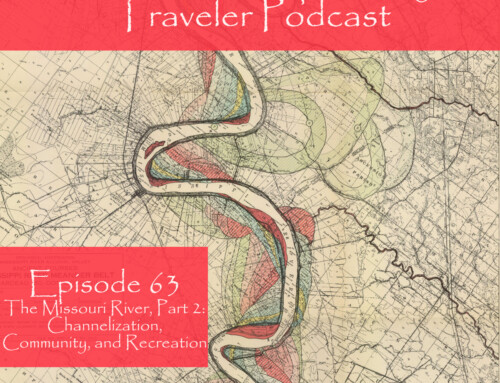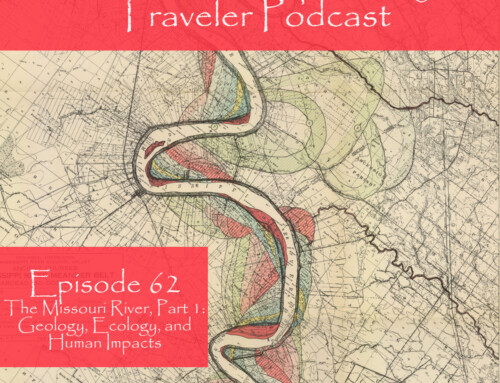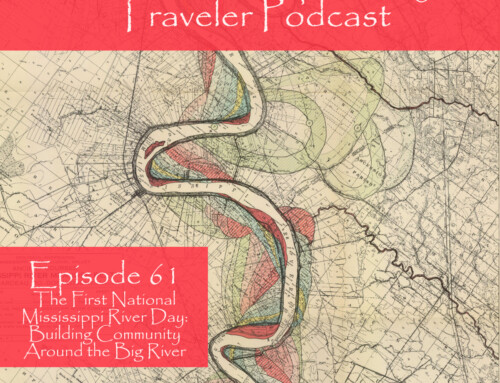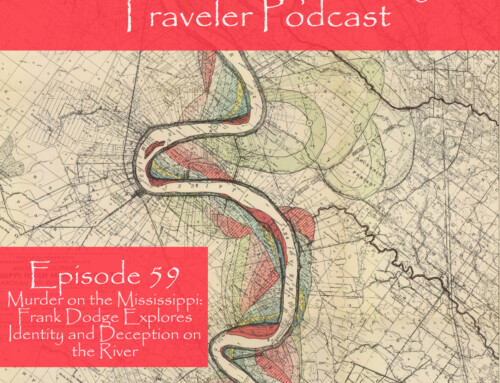The Mississippi River is one of the great attractions in the United States, and the route that parallels the river, the Great River Road, is one of the best drives in America. What makes it so attractive? Why do so many people keep coming back? In this episode, Klinkenberg digs into the major reasons travel along the Mississippi River can be so rewarding, from the rich history along its banks to the inviting small towns and vibrant big cities, to the incredible range of people who live and shape life along the river.
Show Notes
Want to see my list of 21 under-the-radar places to eat? Get a copy of the free book here.
Below, I’ve posted a few pictures from places I mentioned during the podcast. When you have a few minutes, check out the extensive photo galleries of the Mississippi River on this site. I add new pictures regularly, so check back.
Support the Show
If you are enjoying the podcast, please consider showing your support by making a one-time contribution or by supporting as a regular contributor through Patreon. Every dollar you contribute makes it possible for me to continue sharing stories about America’s Greatest River.
Transcript
Dean (00:01):
The Mississippi cuts a deep path through thousands of years of American history. And we can get to know a lot of that history by traveling along the Great River Road.
Dean (00:27):
Welcome to the Mississippi Valley Traveler podcast. I’m Dean Klinkenberg, and I’ve been exploring the deep history and rich culture of the people and places along America’s Greatest River, the Mississippi, since 2007. Join me as I go deep into the characters and places along the river, and occasionally wander into other stories from the Midwest and other rivers. Read the episode show notes and get more information on the Mississippi at MississippiValleyTraveler.com. Let’s get going.
Dean (00:59):
Hey folks. Welcome to episode two of the Mississippi Valley Traveler podcast. In the last episode, I told you about how I got hooked on the Mississippi River. This time around, I want to tell you what I think are some of the biggest draws, some of the main reasons that travel along the Mississippi is so rewarding. People often ask me what I think some of the highlights are. It’s not so much that I’m going to detail highlights today, but I want to describe to you some of the more general experiences that I think are unique to the Mississippi and are the reasons that so many of us keep coming back.
Dean (01:37):
Reason number one. Stories from middle America reflect much of American life. The Mississippi cuts a deep path through thousands of years of American history. And we can get to know a lot of that history by traveling along the Great River Road. Here’s just a real quick sample of some of the possibilities. There are a number of sites that preserve remnants of indigenous communities that lived along the river. They offer interesting peaks into the lives of early American cultures. One of the places you can get a good taste of that is at Effigy Mounds National Monument in northeast Iowa. It’s a collection of mounds of shaped like various animals, including one really fascinating group of bear-shaped mounds on the southern end of the national monument site. These mounds were built about 800 to 1400 years ago, and offer interesting insights into the people who built them.
Dean (02:39):
Cahokia Mounds State Historic Site near St. Louis might be the most well-known of all of these sites. It’s a fascinating place, a big city of perhaps 20,000 or more people who lived in a very well planned, elaborate central city, with thousands more in the countryside in smaller communities around the city. These were Mississippian people, as archeologists classified them. Cahokia Mounds as a city, as a culture peaked about a thousand years ago. But their influence spread far beyond the confluence area around the Mississippi, Missouri and Illinois rivers and descendants of Cahokia moved all over the Southeast, down further toward Louisiana and many moved out west as well.
Dean (03:32):
South of St. Louis there’s another site that I think is just as fascinating as Cahokia Mounds. I don’t think it gets nearly as many visitors, but it should. Poverty Point World Heritage Site in northeast Louisiana peaked about 3,700 years ago. It’s a stunning collection of earthworks that include some mounds, including a really impressive set of semi-elliptical terraces that are oriented toward a plaza. A fascinating place to visit. You should definitely go there. About a hundred miles away from Poverty Point, there’s an even older collection of earthworks at a place known as Watson Brake. I don’t think much of this is open to the public right now, but I just thought I’d mentioned them. At Watson break, there’s a collection of mounds that are 2000 years older than the earthworks at Poverty Point, so they predate the Egyptian pyramids by a thousand years and Stonehenge by 500 years. We don’t often think about how advanced a lot of the cultures were in North America, but there was a lot going on here. This is one of the reasons I think travel along the Mississippi is great, because there are a lot of places you can find out more about the cultures that we hear so little about.
Dean (04:49):
You can also get a good sense of America’s industrial and agricultural history at a number of places along the Mississippi. And there’s a whole bunch of these. One of the most accessible places to get a peak into American industrial history is in Moline, Illinois, at the John Deere sites. At the John Deere Pavilion in downtown Moline, you can crawl around some of the tractors and vehicles that they build. In the past, they’ve also done factory tours at their East Moline facility. During COVID, they haven’t been doing tours, but I’m hoping here in the near future, those will get going again. Besides the John Deere sites, though, you can also get a good sense of our industrial history at the Iron Ranges in Minnesota. I particularly like going up to the Hibbing area and going to the overlook just north of town. Uh, you can get a look into one of the largest open pit iron mines in the world. Further south, the Cotton Museum in Memphis does a great job providing an overview of the long history of cotton agriculture in America.
Dean (06:01):
Now, of course America is more than just building stuff and selling stuff. We have a rich cultural life, and there’s a whole bunch of that along the Mississippi Valley. It ranges from some contemporary activities to a look at some of the cultural highlights from the past. There’s a sculpture garden in Prairie du Chien, Wisconsin, I really like going to. Sculptor Florence Bird has a very ambitious plan to create a couple dozen sculptures that highlight the history of the Mississippi. Appropriately enough, it’s called the Mississippi River Sculpture Park. There are a few of her sculptures in place right now. You should swing by there, if you’re in the Prairie du Chien area.
Dean (06:41):
We’ve got great musical history along the river. People know about the blues, and rightfully so. It’s a great form of music, and there are multiple places where you can get a taste of the blues. There’s a really good blues museum in St. Louis, and there’s another great one in, Clarksdale, Mississippi. I’m pretty sure that there’s some kind of law out there that any time I talk about the Mississippi River, I’m supposed to mention Mark Twain, so I may as well get that in here now. The sites in Hannibal related to Mark Twain are really worth a visit. I really like the museum. They do a good job of giving an overview of his life and explaining his childhood and the influences on his life and his writing. And the boyhood home is an interesting place to walk through.
Dean (07:27):
And for something completely different, when you’re in New Orleans, I just love the culture of the street musicians. You can spend a lot of time listening without ever having to really go inside anywhere and listen to music. You could get in all kinds of music by just wandering around the streets of the city. Of course, there’s a whole bunch more that reflects the rich tapestry of American life. And over time, we’ll get into more of those things. But this is, I just wanted to give you a quick highlight. I didn’t even get into any of the forts along the river, or mention Civil War sites. And there are plenty of those, too. We’ll touch on those in later episodes.
Dean (08:13):
Reason number two: inviting small towns. Along the Great River Road, we are blessed with a number of attractive small towns, small communities, as well as a bunch of big cities. We’ll talk about the cities in just a minute. A lot of these smaller communities offer a nice mix of unique lodging, good food, places to hang out and chat with people, and a lot of recreation nearby. What I really like is that most of these places are owned by local folks. So when I spend a dollar in one of these communities, most of that money will stay in those communities rather than going off to corporate headquarters somewhere else. A lot of these places, you know, they’re just tailor made for leisurely strolls along the river. Many of these communities have beautiful parks they’ve developed in the last 20 or 30 years along the river. Just fantastic places to take it easy, maybe take in a sunset, chat with people a little bit. They’ quite a few of these communities along the Mississippi. I’m just gonna highlight a handful of these with a very quick reason why, you know, what makes them kind of unique.
Dean (09:23):
If we go north, up to Little Falls, Minnesota, they’ve got beautiful parks along the river, and it’s the hometown of aviation pioneer Charles Lindbergh. Down in Alma, Wisconsin, it’s a great place to hang out for a couple days. There’s some good places to eat, some good barbecue there, and some really interesting lodging options. And also what many consider the best views of the Mississippi Valley from the top of Buena Vista Park. Heading a little further south, down to McGregor Iowa, just a cute atmospheric old river town with a bunch of cozy places to stay. And it’s close to spectacular Pikes Peak State Park, which has some great views but also has a number of challenging and interesting hiking trails, as well. Galena, Illinois, is technically a small town though, it may not always feel that way on weekends. It’s one of the most visited communities along the Mississippi Valley, so it can get a little busy on weekends. But there’s a good reason for that. The historic Main Street is just absolutely stunning with the three to four story brick and stone buildings that gently curve along with the Galena River. And that main Street is lined with small, locally-owned businesses.
Dean (10:48):
In my neck of the woods, Kimmswick, Missouri, is a small town right next to the river. It’s a great place to visit for a day trip and go back a few times. It has a number of small boutique shops and antique shops and a couple of really good places to eat. Heading on down further south into the Mississippi Delta, I’m a big fan of Clarksdale, Mississippi. It’s a place with a big history, particularly related to the blues and it’s home of the Quapaw Canoe Company, one of the few places down in the lower part of the river where you can book a canoe trip and get out on the Mississippi and feel the river for yourself. And then I’ll just highlight one more. I really like Saint Francisville, Louisiana, as well, which feels very elegant, a beautiful Southern town with lovely places to stay. It’s just tailor-made for a quiet relaxing weekend.
Dean (11:46):
Reason number three: vibrant big cities. So we covered the small towns, so let’s go to the other end of the spectrum. We’ve got some fantastic big cities along the Mississippi river, Minneapolis St. Paul, the Quad Cities region of Illinois and Iowa, St. Louis, Memphis, New Orleans. These are all famous cities and for very good reasons. All of these cities have a wide variety of things to do and ways to pass the time. I’m just gonna quickly highlight a few of them just to wet your appetites a little bit. There’s an amazing amount of art in each of these river communities. You can go to the Walker Art Center in Minneapolis and spend some time checking out more contemporary pieces of art. You can go to the New Orleans Art Museum for a mix of classic and contemporary works of art. And then the flood walls in places like St. Louis and others often been opened up for artists of various kinds to offer their interpretations of history or some cultural theme. In St. Louis, we have graffiti artists who are invited here once a year to decorate the flood wall and bring some life to it.
Dean (13:03):
There’s lots of great music in our big cities: blues, jazz, hip hop country, rock, choose your genre. There’s gonna be somebody, some musician, playing that style of music in each of these places. So you can go take in a show and see your favorite musicians, maybe people you’re already familiar with at a place like First Avenue in Minneapolis, the club that prince made famous. Head to the Capital Theater in Davenport, Iowa, or BB King’s Blues Club in Memphis, or just a classic venue–Preservation Hall in New Orleans. But don’t overlook the dozens of smaller venues and bars where you can grow to love great musicians you’ve never heard of. Some of these are places like the Washington in Burlington, Iowa, the Loading Dock in Grafton, Illinois, and the Trempealeau Hotel in Trempealeau, Wisconsin. If you like live theater, like I do, the big cities in our Mississippi Valley have plenty of options for that as well. Minneapolis has a vibrant theater district and may have more theaters per capita than any of the communities along the Mississippi. They also have one of the most spectacular, the Guthrie, that is right on the Mississippi itself. In our river towns you’ll find Shakespeare festivals in places from Winona to St. Louis. In St. Louis, we have the elegant, over the top Fox Theater, which is a fantastic place to take in a show. Go check out a show at the Orpheum in Memphis.
Dean (14:39):
And food. Oh my goodness. We’re gonna be doing so many episodes on food. So let’s just quickly highlight a few of the most obvious options: great Vietnamese food in St. Paul; you can get really good Italian food in St. Louis; Memphis–come on barbecue; gotta get some fried chicken in the Delta; anything on a plate to new Orleans. You just can’t go wrong. We’ve got some unique food items along the Mississippi Valley as well. So if you’re up in the Twin Cities region, you can get a juicy Lucy. In the Quad Cities and in parts of Iowa, look for tenderloin sandwiches. Some of them are so big, you might need four hands to actually lift it up and get it to your mouth. And St. Louis, we’ve got toasted ravioli. Don’t know what that is? Come here and find out. And, down in the Mississippi Delta, they have their own version of tamales that are gonna be unlike the tamales you might be familiar with, if you eat in a lot of Mexican restaurants.
Dean (15:45):
If you’re enjoying the show, share that love with other people. Leave a review on iTunes or your preferred podcast app. Each review makes a difference and helps other fans of the Mississippi River and the Midwest find this show.
Dean (15:59):
Moving on. Reason number four: seasons. We have seasons along the Mississippi River. This isn’t San Diego, where every day it’s 72 degrees for highs and 50 degrees for the low. We have a lot of variation and something new is going on every time of year. In the spring, as the snow melts up north, the river rises and birds migrate north toward their summer homes, particularly songbirds. You can hear dozens of varieties of songbirds along the Mississippi Valley in March and April. And of course, there’ll be an impressive range of flowers that’ll be blooming along the forest floor and the prairies. Along the river, summer is obviously the peak recreation time. It’s the busiest travel time in parts of the Mississippi Valley. It’s hot. It can be muggy, and we love hanging out on beaches, especially on those Mississippi River islands and those great sand bars. And of course, you’ve also gotta prepare to swat some mosquitoes or maybe spray on some repellent to keep the bugs away from you. Fall is another migration season. Tundra swans are one of the more unique migratory creatures you can find along the river valley. They stop around the Brownsville (Minnesota) and La Crosse (Wisconsin) area and will stick around for a few weeks until the river freezes over. It’s quite a sight to see hundreds of those large and beautiful birds, all congregated together and feeding. And of course we have plenty of fall color, particularly in the bluffs. The bluff lines will be covered with shades of red, orange and yellow. Winter. Yeah, I know not everybody likes cold weather. We do have plenty of that particularly along the northern third or so of the river. If you’re into ice fishing, it’s a great place to be for ice fishing. And St. Paul has one of the more unique festivals in the country. Their winter carnival is great fun, and I tell you, it’s quite invigorating to be standing outside on a downtown street when it’s 15 degrees watching a parade pass in front of you. Everybody should have that experience at least once. If you prefer warmer weather for some reason–everybody has their preferences. I know–there are plenty of warmer spots along the Gulf Coast at the end of the river, around new Orleans and further south. So, you can escape the ice with just a few hours of flying or maybe a day or two driving time.
Dean (18:35):
Reason number five: the Mississippi valley showcases a cross section of America. So you know, there are Americans from many, many different backgrounds that have lived and currently live along the Mississippi River. When the first Euro Americans began moving into the Mississippi Valley, there were dozens of Native American communities that lived along or near the river. Some Native American communities are still connected to the river today, particularly in the northern and southern ends of the Mississippi. Up north in Minnesota, you’ll find communities of Ojibwe people and Dakota people at the upper end of the river. There are communities of Chitimacha in Louisiana, as well as other communities. Now if you’re in one of these areas and you’re interested in connecting with any of those Native American communities, one of the easiest ways to do that is to go to a pow wow, but I’d also check the tribal colleges in the area. Many of them have events that are open to the public, and it’s a good way to connect with Native communities as well.
Dean (19:44):
Now for those of us who are from more European or Euro-American backgrounds, there are also a number of places along the Mississippi, where you can still find an impressive range of backgrounds. New Orleans and St. Genevieve (Missouri) still retain strong influences from the early French founders. Fulton, Illinois still celebrates its Dutch heritage, and, in fact, you can buy some Dutch food items at the local meat market. The Quad Cities of Illinois and Iowa, basically Rock Island and Davenport, have the only interstate St Patrick’s Day parade. So even if you’re not Irish, you can enjoy, the only parade in the country that crosses state lines. There’s a Mexican-American community in Fort Madison, Iowa that has been throwing a late summer fiesta to celebrate their heritage for over a century. In Guttenberg Iowa, the community has strong German roots and every year they throw a festival that celebrates that German heritage. In Donaldson Louisiana, the River Road African American Museum is a great place to get a look at the lives and experiences of Africans and African Americans in the United States. And then, you know, there are scattered ethnic groups everywhere along the Mississippi. You can find Finns and Czechs and Slovaks in northern Minnesota. Norwegians and Swedes in Minnesota and Wisconsin. Somalis in St. Cloud and Minneapolis. Poles from the Kashubia region in Winona, Minnesota. Belgians in the Quad Cities. Iraqis and Afghanis in St. Louis. Chinese Americans throughout the Mississippi Delta and Jewish communities scattered up and down the Mississippi Valley. And again, these are just a few examples, not a complete list of every group that has lived or currently lives along the Mississippi, so don’t send me an angry tweet if I miss somebody that’s part of your background. It’s no secret why there’s so much diversity along the river. The Mississippi has been a home and passageway for just about every group that has lived in North America or that moved here, and many river communities still celebrate those ties today. So a trip on the Great River Road is a really good reminder that the Mississippi Valley and United States have been shaped by the contributions of people from many different backgrounds.
Dean (22:24):
And last and certainly not least, reason number six is the river itself. Of course; it’s the main attraction. It’s the reason we’re all here. It’s because of the beauty and the opportunities to get outside that are presented by the Mississippi. There are so many ways to experience it. You can take in wide views from the tops of tall bluffs, or maybe just have a quiet picnic next to the river somewhere or on a sandbar. Here are a few of my favorite ways to explore the Mississippi and enjoy it. Hiking. I mentioned a little bit about this in episode one. There are so many public lands along the Mississippi. You could not get through every single one in a lifetime. I’m sure trying, though. I hope to get through most of them. But there are lots of different places to go for hikes. Some of them are nice flat, easy hikes through floodplain forests. Some offer more challenging hikes that will take you up the side of a bluff to the top. Biking is another good option. There is a signed route, the Mississippi River Trail, that follows the entire river. Some of it, does follow the shoulders of highways, but there are places where there are dedicated bike trails. Boating is a great way to get out on the river and enjoy it. And there are plenty of places to put in. It’s especially popular along the upper part of the river. You get north of St. Louis and you’ll see lots and lots of recreational boaters out, especially on weekends. Paddling is one of my favorite ways to get out. I love getting out in a small boat that operates under my own power, and I can feel myself more in sync with the river’s rhythms when I do so. Plus I don’t scare away the wildlife nearly as much as the motorboats do. Photography. Yeah. A lot of people love just coming out to the river to take pictures and who can blame ’em? There are so many scenic views. The river offers something new every day, at different times of day throughout the seasons. And if you have any doubt about this, just go on Facebook and look up the Mississippi River photos group, which has nearly 110,000 members now, who are busy posting photos of the Mississippi every single day.
Dean (24:47):
One of the main attractions of the Mississippi is birding, as well. I’m not an especially active birder. I’m partially colorblind, which limits some of my ability to identify different species of birds. But from what I understand, there are lots of amazing places to visit the river and look for a variety of bird species, so you can check off a lot of different species on your life list. There are a lot of birds of prey too, so it’s not just the songbirds. It’s not just ducks. There’s quite a range of birds of prey. One of my favorite activities is on a warm afternoons when I sit around and I watch the birds of prey making lazy circles in the sky, you know, catching thermals around the tops of bluffs.
Dean (25:37):
So that’s a quick list. That’s a quick overview. Those are what I think are the six primary reasons that travel along the Mississippi River is so rewarding. Did I miss something? Let me know, drop me a note at my website, MississippiValleyTraveler.com.
Dean (26:08):
And now it’s time for the Mississippi Minute: a quick tip, highlighting a particular place, maybe a note on a timely topic, or whatever’s on my mind. We all have to eat. We all have our own preferences. I’m a pretty adventurous eater. I once ate roasted crickets that I bought from a food stall in Bangkok. Don’t worry, though. I’m not gonna be steering you to that kind of place. I have gotten a little pickier about some things as I’ve gotten older. I really now have a strong preference for eating at locally-owned restaurants rather than chains. It’s partly philosophical. I like knowing that more of every dollar I spend stays in the local community rather than going to corporate offices somewhere and shareholders who have no stake in that local community. Some of the reason is about the food too. Eating in local restaurants can be a good way to explore those unique or local preferences.
Dean (27:01):
And sometimes you get a different spin on food that is otherwise familiar to you. And most of the time I think the food is just fresher, and I think, generally speaking, I get better service in those places. You know, these local bars and restaurants are a great way to meet people also, and to find out more about the community you’re visiting. So that’s another big plus. Most of the time, it’s really not all that hard to find the most popular places in town and often they’re popular for good reason. I’ve also been lucky enough to find places that don’t necessarily make the top of those popularity lists, but they’re still great places to eat. I’ve put together a list of some of my favorites that fit into this category, 21 of them, in fact, and you can download a copy of that for free at my website, MississippiValleyTraveler.com/free-book.
Dean (27:55):
Thanks for listening. If you enjoyed this episode, subscribe to the series on your favorite podcast app, so you don’t miss out on future episodes. I offer the podcast for free, but when you support the show with a few bucks through Patreon, you help keep the program going. Just go to patreon.com/DeanKlinkenberg. If you want to know more about the Mississippi River, check out my books. I write the Mississippi Valley Traveler guidebooks for people who want to get to know the Mississippi better. I also write the Frank Dodge mystery series set in places along the river. Find them wherever books are sold. The Mississippi Valley Traveler podcast is written and produced by me, Dean Klinkenberg. Original music by Noah Fence. See you next time.
